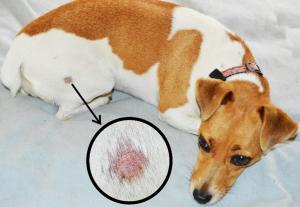What is ringworm?
Ringworm is a contagious disease caused by a fungus that attacks the hair.
It can be transmitted from one species to another, and even to humans. It is hence a zoonosis, i.e. a disease that can be transmitted from animals to humans. The ringworm fungus is also very resistant in the animals’ environment, in soils, furniture and gardens, which can complicate control.
What causes ringworm?
The agents responsible for ringworm are called "dermatophytes", the fungi that cause ringworm to develop.
There are 3 genera of dermatophytes: Microsporum, Trychophyton and Epidermophyton.
These fungi secrete substances that digest the keratin present in the hair. They produce spores (like pollen) that are responsible for contagion between individuals. The spores are very resistant and can survive up to 2 years in the outside environment.
What does ringworm look like?
Ringworm in horses
Horses can be infected directly by contact with a carrier animal or via spores present in the environment. The fungi responsible for ringworm in horses are: Trichophyton (T.equinum and T.mentagrophytes) and Microsporum (M.gypseum and M.canis).
After contamination, the fungi colonize the hair and cause it to deteriorate then fall out. This fall will lead to characteristic lesions on the skin of the horse. As symptoms appear, we see round hairless areas appearing in the shape of a coin. At the beginning of the development the lesions are in localized areas, but they can spread on the whole body. This disease does not usually cause the horse to itch.
Some horses may be carriers of ringworm without showing clinical signs. Contamination between horse and human is rare, but not impossible.
Your veterinarian can help identify the disease by the external appearance of the lesions but also by taking a hair sample to identify the type of fungus.
Ringworm in cattle
Ringworm in cattle is also due to a fungus but it is not identical to that of the horse: it is Trichophyton verrucosum.
As with horses, transmission is by direct contact between animals and via spores present in the environment. As with horses, transmission to humans is possible and some animals may be carriers without associated symptoms.
The contamination is more important in winter, when cows are indoors and in close contact with one another.
The lesions have the same shape as in the horse.
Dermatophyte vaccine can be administered to reduce the clinical signs and the recovery time of ringworm in cattle. However, if a vaccination protocol is in place, every animal joining the herd as a new arrival should be quarantined and vaccinated.
Ringworm in dogs
In dogs there are usually 2 fungi: Microsporum canis and Trichophyton mentagrophytes. Ringworm in dogs can be transmitted to humans, and owners are often found with ringworm lesions / rash because the animals live in the same environment as their owners, unlike horses and cattle.
The lesions are also round in shape and can have a crusty appearance. Itching is more frequent than in horses and cows, although not systematic. The animal can aggravate the depilated areas and make them inflammatory by scratching. The diagnosis can be made with a specific lamp that will highlight the areas where fungi develop on the hair. Hair samples can also be taken to identify the fungus.
How to cure ringworm
Ringworm treatment for horses and cattle
Treatment must be done at the level of the horse, but also of its environment. The affected horse must be isolated to prevent it from contaminating other horses. Also, do not use the same equipment on the affected horse and healthy horses (textiles, brushes, tack, but also riding boots ...) For the horse, it is necessary to treat the hair with a topical product like enilconazole. To avoid recurrence, the environment and equipment must also be treated.
As with horses, cattle ringworm treatment involves disinfection of the animals' living environment and elimination of the animals' hair with a topical agent such as enilconazole. A prophylactic and therapeutic dermatophyte antigen vaccine is licensed for use in cattle from 2 months of age.
Ringworm treatment for dogs
The ringworm treatment in dogs is often done with a combination of 3 elements to get rid of ringworm:
- Topical antifungal treatment such as enilconazole or chlorhexidine-miconazole combination to sanitize the coat
- Oral antifungal treatment such as griseofulvin, ketoconazole or itraconazole
- Shearing may be necessary in some cases to eliminate fungal growth areas
Do not forget to treat the environment to eliminate the spores that are present.
Ringworm can also affect other animals like cats, rabbits, guinea pigs... When in doubt, do not hesitate to reach out to your veterinarian for advice.
Written by: Audevard Laboratories (Guest Author)
